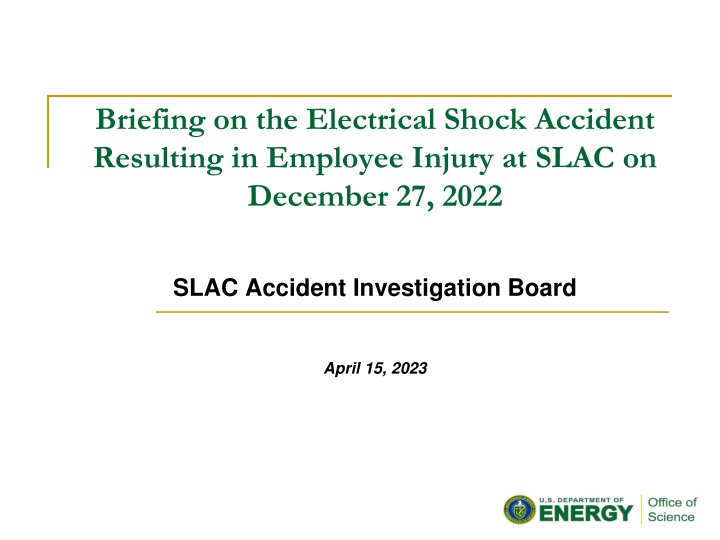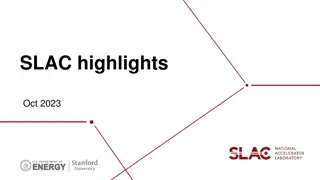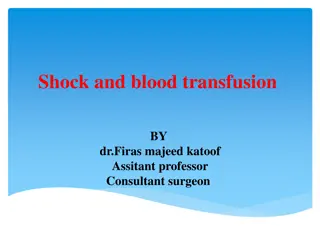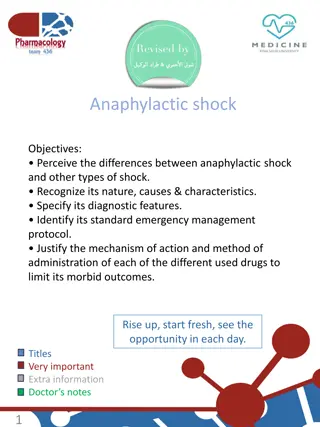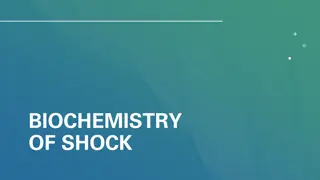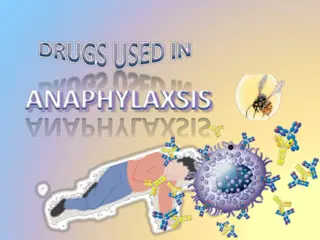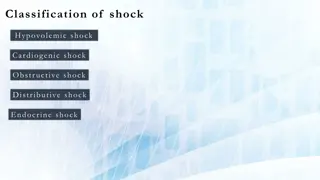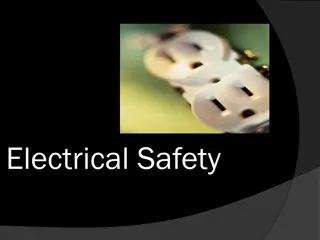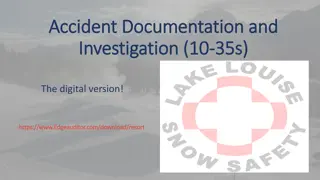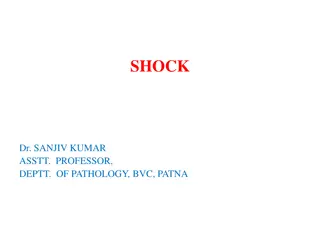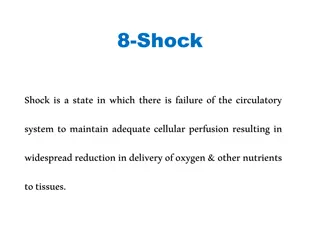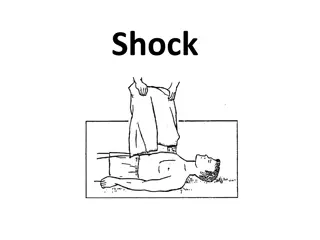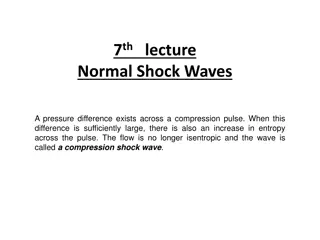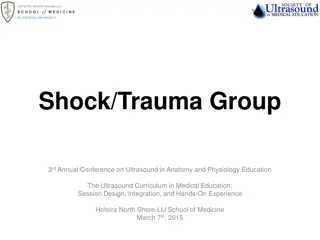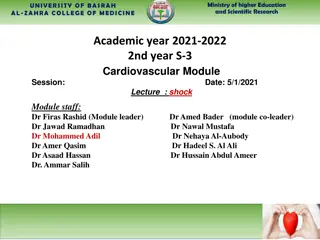Electrical Shock Accident Investigation Report at SLAC
SLAC's Accident Investigation Board analyzed an electrical shock incident resulting in severe employee injuries, focusing on identifying causes and making recommendations to prevent future accidents. The investigation, conducted in accordance with DOE guidelines, highlighted critical deficiencies in hazardous energy control procedures. Early communication to SLAC management emphasized the urgent need for improvements to enhance employee safety and prevent similar incidents.
Download Presentation

Please find below an Image/Link to download the presentation.
The content on the website is provided AS IS for your information and personal use only. It may not be sold, licensed, or shared on other websites without obtaining consent from the author.If you encounter any issues during the download, it is possible that the publisher has removed the file from their server.
You are allowed to download the files provided on this website for personal or commercial use, subject to the condition that they are used lawfully. All files are the property of their respective owners.
The content on the website is provided AS IS for your information and personal use only. It may not be sold, licensed, or shared on other websites without obtaining consent from the author.
E N D
Presentation Transcript
Briefing on the Electrical Shock Accident Resulting in Employee Injury at SLAC on December 27, 2022 SLAC Accident Investigation Board April 15, 2023
Electrical Shock Accident Resulting in Employee Injury at SLAC on December 27, 2022 Background On 12/27/2022, in preparation for scheduled preventive maintenance work activities on several electrical substations and downstream loads, a SLAC National Accelerator Laboratory (SLAC) High Voltage Electrician made hand contact with a bare energized (live) circuit part inside a 12.47 kV three-phase electrical switchgear cubicle, resulting in severe injuries to the hands and face. On 12/29/2022, the SC DDFO chartered a DOE Accident Investigation to determine the facts and circumstances related to the event and identify possible weaknesses in institutional Lockout/Tagout (LOTO) and Work Planning and Control programs at SLAC. 2
Electrical Shock Accident Resulting in Employee Injury at SLAC on December 27, 2022 Board Activities An accident investigation seeks to understand what happened, how it happened, and to make recommendations for actions to prevent it from happening again. The Board s objective was to analyze the event and determine direct, root, and contributing causes, formulate conclusions, and from these provide Judgments of Need. Our analysis was based on the requirements in place at SLAC at the time of the accident pursuant to the contract. This was not a compliance review. While not knowing the extent of the injuries to the employee, we know that the effects were devastating. This impacted the Board and compelled us to thoroughly identify and analyze, to the maximum extent possible, factors that could mitigate a similar accident. 3
Electrical Shock Accident Resulting in Employee Injury at SLAC on December 27, 2022 Board Activities (cont.) This investigation was conducted in accordance with DOE 225.1B and DOE-HDBK-1208-2012. Facts were gathered through interviews, document and evidence reviews, and examination of physical evidence. Analysis was conducted utilizing barrier and change analysis, events and causal factor charting, and human error precursor analysis to identify causes and develop conclusions. Onsite from 1/16/2023 through 1/26/2023. Analysis and report writing from 1/20/2023 through 3/23/2023. Factual accuracy conducted 3/20-21/2023. Quality review conducted 3/24/2023 through 4/6/2023. Comment resolution from 4/7/2023 through 4/14/2023. Report provided to Appointing Official on 4/17/2023. 4
Electrical Shock Accident Resulting in Employee Injury at SLAC on December 27, 2022 Early Communication to SLAC Management After four days onsite, the Board identified four specific critical items of an urgent nature: Multiple required elements of Chapter 51, Control of Hazardous Energy are not being followed. This results in elevated risk to employees and subcontractors performing work under these hazardous energy controls. Troubling examples include 1) work is being authorized before LOTO procedures are fully completed, and 2) procedures are being performed out of sequence or split up between personnel to be done in parallel. The management in F&O electrical maintenance planning are not actively engaged in supervising work at the job site, do not appear to fully recognize work practice deficiencies, or consistently address deficiencies when identified. Conduct of electrical job briefings in support of Switching Orders and LOTO procedures are not effectively identifying hazards and implementing controls per the plan. For example, the board has observed instances where electrical job briefings are not being done immediately before the job, hazards and controls are not discussed, and there is no discussion of what could go wrong or emergency response actions. Planning and execution of field work is overly dependent on expert-based capabilities rather than supervised procedural compliance. These were communicated to SLAC and SSO Management on 1/20/2023. The relevance of these will be noted ( ) in the Board s results. 5
Electrical Shock Accident Resulting in Employee Injury at SLAC on December 27, 2022 Response to Charter The investigation charter had eight required review elements, all of which were addressed as part of the normal investigation process. Three of these elements were tailored to this accident. The Board determined: SLAC WPC processes were inadequate in determining the scope of work, identification of hazard and associated controls prior to performance of work. Corrective actions from previous LOTO and work control incidents were either not completed or ineffective to prevent similar issues. Broader systemic weaknesses were identified in the Laboratory s WPC and LOTO programs. Systematic weaknesses were also identified in configuration management. These items are documented throughout the Board report and are summarized in the results briefing to follow. 6
Electrical Shock Accident Resulting in Employee Injury at SLAC on December 27, 2022 Key Messages The Board determined that the principal mechanism of injury was a high voltage electrical shock. The ESH Program manual is a fairly solid written program. The Board observed that all of the SLAC workers and managers interviewed: Were transparent and cooperative with the Board, and Demonstrated a desire to perform work safely. 7
Electrical Shock Accident Resulting in Employee Injury at SLAC on December 27, 2022 Key Messages Fundamental issues identified in SLAC s management of physical assets, procedure-based work execution, as well as program assessments and corrective action management: SLAC infrastructure priorities and configuration of systems failed to ensure a stable physical configuration of the electrical distribution system for safe conduct of work activities SLAC failed to effectively evaluate worker comprehension and implementation of its policies and procedures and to provide sufficient supervisory and management presence in the field to assess implementation Long-standing conditions present at the time of the accident were recognized by SLAC from prior assessment activities, but corrective action commitments remained open and unresolved. 8
Electrical Shock Accident Resulting in Employee Injury at SLAC on December 27, 2022 Key Messages (cont.) Section 4.2 identifies the various elements of the Anatomy of the Event model to enable the reader to better appreciate how this accident was able to occur through discussion of latent organizational weaknesses; flawed controls; error precursors; vision beliefs and values; and initiating action. In summary: The accumulated complexity of the electrical distribution system overwhelmed the ability to develop a safe and executable work plan, introducing a new hazard (partially energized gear) without being identified or controlled. A culture of over-reliance on experienced workers with PPE short- circuited the need for detailed work plan reviews and walkdowns and fell victim to errors of inattention and reduced perception of risk. Inadequate field assessments over several years allowed this culture to self-reinforce and take root, and the issues related to configuration management that had been identified for years were never corrected. 9
Electrical Shock Accident Resulting in Employee Injury at SLAC on December 27, 2022 Error Precursors In conjunction with the other analytical tools, the Board identified error precursors that existed in relation to the accident. Key examples include: Task Demands Time pressure (sense of urgency due to environmental conditions) Interpretation requirements (situations requiring 'in-field' diagnosis) Lack of or unclear standards Work Environment Changes/departures from routine Hidden system/equipment response Unexpected equipment conditions Lack of alternative indication (system or equipment) Individual Capabilities Imprecise communication habits Human Nature Inaccurate risk perception Mindset The most prevalent error precursor was inaccurate risk perception, appearing five times, followed closely by interpretation requirements. 10
Electrical Shock Accident Resulting in Employee Injury at SLAC on December 27, 2022 Results - Direct Cause The injured high voltage electrician made hand contact with a bare energized (live) circuit part inside a 12.47 kV three-phase electrical utility distribution switchgear cubicle. 11
Electrical Shock Accident Resulting in Employee Injury at SLAC on December 27, 2022 Results: Contributing Causes Configuration Mgmt Compliance to maintenance requirements without sufficient resources resulted in reactive changes to the physical configuration of the 12.47 kV distribution system, with unintended consequences that increased complexity for work performed (CC-2). Multiple configuration changes to the electrical distribution system feeding IR-2 and S522 during the previous years did not include the updating of applicable drawings, equipment identifications tags, and arc flash labels to reflect actual field conditions (CC-3). 12
Electrical Shock Accident Resulting in Employee Injury at SLAC on December 27, 2022 Results: Contributing Causes WPC - Planning The outage planning process assigned insufficient resources and time for the increased maintenance scope and, instead, staggered the outage plan that introduced partially energized switchgear (CC-4). The planning process failed to produce a work package that could be executed safely (CC-5). Unclear expectations for walkdowns resulted in miscommunication of the scope, hazards, and controls from the planning group to the workers executing the work, and a lost opportunity to identify issues with the work package (CC-6). A comprehensive Tailgate Briefing was not performed to fully communicate the roles and responsibilities as well as task-level scope, hazards, and controls, to all of the assigned workers (CC-7). 13
Electrical Shock Accident Resulting in Employee Injury at SLAC on December 27, 2022 Results: Contributing Causes WPC - Execution The work team deviated multiple times from the approved work plan without stopping either to question why they were doing it or analyze the hazards, which led to reliance on skill-based rather than rule- based execution (CC-8). Workers and Planners did not understand how to apply and control the shock and arc flash boundaries, resulting in worker exposure without appropriate PPE (CC-9). Ineffective communications during the execution of the Switching Order resulted in critical information on equipment status indicators being ignored and hazards not being recognized (CC-10). The lack of field oversight, ineffective self-assessments, and lack of reinforcement of the need to follow established CoHE and safe electrical work practices resulted in a complete loss of administrative and physical control of the CoHE/LOTO Program (CC-1). 14
Electrical Shock Accident Resulting in Employee Injury at SLAC on December 27, 2022 Results: Root Cause Management failed to ensure effective continuous evaluation and oversight of mission support infrastructure and programs to identify and manage risks in work execution: Infrastructure priorities and configuration of systems failed to ensure a stable physical configuration for safe conduct of work activities. Field oversight failed to detect issues related to the effectiveness of SLAC procedures and their implementation during work activities. The institutional issues management process failed to ensure that identified program issues were corrected, evaluated for effectiveness, documented, and closed in a timely manner. This root cause is reflective of the many elements represented in the contributing causes. 15
Electrical Shock Accident Resulting in Employee Injury at SLAC on December 27, 2022 DOE Oversight SSO Manager, along with their management team, has established an engaged and open relationship with the contractor. SSO has both pandemic related and staffing challenges that are actively being addressed. SSO has cancelled most assessments and is heavily focused on field engagement rather than formal assessment. SSO has provided consistent written feedback to SLAC management on incidents and issues with questions, expectations, and even technical direction to bring attention and action to bear. SSO (and HQ) have provided explicit evaluations in the annual PER regarding SLAC's operational performance and lowered ratings. SSO oversight was not effective in ensuring that SLAC s programs were sufficiently robust to prevent the increasing trend of safety incidents since 2020, and ultimately this accident. While these measures over the last two years failed to result in a turnaround of SLAC operational performance, the Board determined that DOE oversight was not a causal factor in this accident.
Electrical Shock Accident Resulting in Employee Injury at SLAC on December 27, 2022 Results: Conclusions (CONs) Less than adequate configuration management led to inaccurate representation of the electrical distribution system (CON-6) Work Planning and Control failed to properly identify the hazards and controls associated with the work (CON-1) SLAC Management failed to provide oversight of critical work planning elements (CON-2) SLAC Management failed to establish defined roles and responsibilities for the work (CON-3) Inaccurate mental model led to wrong actions taken (CON-7) Skill-based performance mode led to erosion of procedural compliance (CON-8) Lack of management oversight and supervision led to normalization of deviations in work practices (CON-4) There was a complete loss of administrative and physical control of the CoHE/LOTO process (CON-5) 17
Electrical Shock Accident Resulting in Employee Injury at SLAC on December 27, 2022 Results: Judgments of Need (JONs) The Board identified 16 JONs: Configuration Management Stanford University needs to assure infrastructure risks are evaluated, documented, and managed (JON 1) SLAC Management needs to ensure that configuration of systems is accurately documented consistent with field conditions and available for use (JON 2) Given the number of temporary modifications that have become permanent, SLAC EPD needs to develop and implement a risk- informed plan that aligns the electrical system configuration to safely support operations and maintenance activities (JON 3) SLAC Management needs to validate and maintain accurate equipment identification and hazard labels (JON 5) 18
Electrical Shock Accident Resulting in Employee Injury at SLAC on December 27, 2022 Results: Judgments of Need (JONs) Work Planning and Control SLAC management needs to evaluate the operational risk associated with the EPD maintenance program test failures in advance of work authorization. (JON 4) SLAC Management needs to ensure that the known human performance improvement error precursors are considered in work planning processes and during work execution (JON 12) SLAC Management needs to clarify and reinforce requirements for preparation, review, and approval of work plans (JON 8) SLAC Management needs to ensure processes align known hazards with controls throughout the work planning and execution (JON 9) SLAC Management needs to ensure the alignment between the EWP, SWO, and EIP, including better defined roles and responsibilities and interdependence between the documents (JON 13) SLAC Management needs to define requirements and expectations for walkdowns during work planning processes and prior to work performance (JON 10) SLAC Management needs to strengthen requirements and expectations for tailgate briefings (JON 11) 19
Electrical Shock Accident Resulting in Employee Injury at SLAC on December 27, 2022 Results: Judgments of Need (JONs) SLAC Supervisors need to conduct ongoing field verification of compliance with approved work plans, including mandatory step-by- step sequencing where required (JON 14) SLAC Management needs to ensure that continuing training effectively confirms worker competency to perform CoHE activities through practical demonstration (JON 7) SLAC Management needs to ensure CoHE Program assessment and required annual periodic inspections are conducted (JON 15) SLAC Management needs to ensure issues and corrective actions are consistently documented, prioritized, and objectively tracked to closure (JON 6) SLAC needs to reassess their level of readiness to respond to accident situations (JON 16) 20
